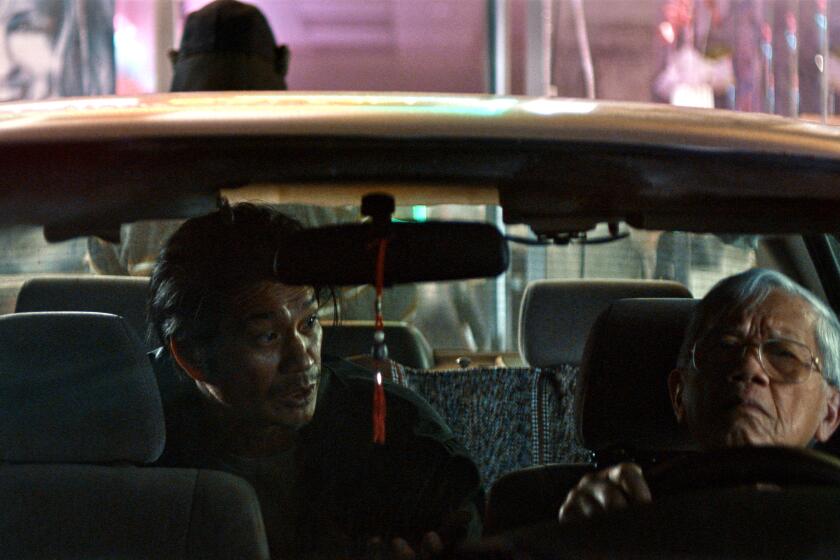Review: Norway’s ‘The Wave’ shows Hollywood how to make a disaster film with real thrills
- Share via
Given its title, it will come as no surprise that a towering, terrifying wall of water is front and center in the Norwegian disaster movie “The Wave,” but that’s not the only reason to see it.
Rather, as directed by Roar Uthaug, “The Wave” adds credible writing and effective acting to gangbusters special effects, resulting in a white-knuckle experience a bit higher on the plausibility scale than what we’re used to from Hollywood versions of the genre.
See more of Entertainment’s top stories on Facebook >>
Though Norway has not previously been known as a world leader in disaster film production, it helps “The Wave’s” credibility that, as old newsreel footage that starts the film informs us, its premise is one based on past reality.
Given that there are numerous mountainsides in the country, when one of them lets go and sends a wave of rocks into the waters of a narrow fiord, the confining conditions of those high cliffs can create a monster wave 240 feet tall. And heaven help whatever hapless picturesque hamlet lies in its way.
Welcome to scenic Geiranger, a stunning UNESCO World Heritage site overlooked by the towering mountain Akerneset and beautifully photographed by John Christian Rosenlund. But that visual splendor, though a mecca for tourists, comes with the fatal flaw of potential inundation.
The good people of Geiranger are of course well aware of this potential. They’ve set up an Early Warning Center that scientifically monitors the mountain for potential disturbances, a facility that comes complete with a bright red panic button. Once conditions warrant it being pushed, everyone in town will have 10 minutes to move like heck toward higher ground.
In his interview with fellow director Francois Truffaut, Alfred Hitchcock talked persuasively about the difference between surprise and suspense, and “The Wave” is all about suspense. Everyone who watches the film knows that while scoffers in town may scoff, a wave is coming sooner rather than later. The questions are simply when will it show up, what will it look like, and who will survive.
As written by John Kare Raake and Harold Rosenlow Eeg, “The Wave” unpacks its plot with all deliberate speed, squeezing every possible ounce of jeopardy and peril out of the buildup to and aftermath of the Big One.
At the center of things is 40-year-old family man Kristian (Kristoffer Joner), who lives in Geiranger with his capable wife, Idun (Ane Dahl Torp), and their two children, slightly disaffected teen Sondre (Jonas Hoff Oftebro) and his button-cute younger sister, Julia (Edith Haagenrud-Sande).
Kristian has been the top geologist at Geiranger’s Early Warning Center, but as the film opens he has taken a job with an oil company in a bigger city and is moving his family out of town.
A stickler who makes people double- and triple-check readings, Kristian is packing up his desk at the center when some troubling data start to appear: the ground water readings on the mountain have suddenly gone wonky.
Without an advanced degree in geology, it’s impossible for civilians to say exactly why this is a problem, but Kristian won’t let that fact go. Sensing something he cannot prove, he becomes convinced that the Big One is coming, and soon.
That suspicion leads to one of “The Wave’s” tension-building episodes, when Kristian’s colleagues take a helicopter up to the Eagle’s Nest Control Center and physically enter a way-claustrophobic crevice to check on the warning system themselves.
All this takes so much time that it puts a crimp in the family leaving plan, mightily irritating wife Idun, who works as a receptionist at the town’s top hotel, which just happens to be right in the tsunami’s path.
Then all of a sudden it happens. The red button gets pushed, and a ferociously frightening wave (created by Norway’s Gimpville and visual effects supervisor Lars Erik Hansen) does its worst, leaving complete havoc in its wake.
Making the question of who shall live and who shall die more involving than standard Hollywood fare is good naturalistic acting by people whose faces are not known in this country and whose dilemmas work out in ways that can be outside the conventional disaster film box.
The last thing “The Wave” puts on screen is a text reading “All experts agree there will be another rock slide. No one knows when.” To residents of the earthquake-prone Golden State, that statement, and much of this film, have a chillingly familiar ring.
------------
‘The Wave’
MPAA rating: R, for some language, disaster images
Running time: 1 hour, 45 minutes
Playing: Nuart, West Los Angeles
More to Read
Only good movies
Get the Indie Focus newsletter, Mark Olsen's weekly guide to the world of cinema.
You may occasionally receive promotional content from the Los Angeles Times.










